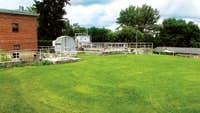With just 10,000 residents, Pulaski is a small town located in Pulaski County, in southwestern Virginia. The town’s sole water treatment plant was constructed in 1951 as a conventional 4-million-gal-per-day plant with coagulation, sedimentation and filtration processes. The contract for the construction of the plant was awarded to F.L. Showalter Inc., with filter equipment and steel tank contracts awarded to Robert’s Filter Mfg. Co., and the Chicago Bridge & Iron Co., respectively. The plant was built with four 750,000-gal rapid sand filter units, coke tray aerators, a mixer basin equipped with an Infilco accelerator, a carbon dioxide contact chamber, a coagulation basin, an oil-fired carbon dioxide generator, sand filters, chemical feeders, lift pumps and booster pumps.
Plant Processes
The source of the town’s water is a clear mountain stream located about 6 miles west of Pulaski, called Peak Creek. According to Gary McCollum, senior engineer, Draper Aden Associates, design engineer for the Town of Pulaski Water Treatment Plant Upgrade project, the water goes through a detailed process to meet the state’s stringent regulations for turbidity. “Although Peak Creek typically runs under 5 ntu, we’ve got to get down to fractional levels,” McCollum said. “Sometimes the source will kick up to 60 or 100 ntu during a storm event, so then the treatment process is very valuable.”
After creek flow is pumped up to the water treatment plant, it gets metered, a chemical is added and a flocculent called Brennfloc is used. The water then goes into the superpulsator—a technology that utilizes a flocculation/clarification unit to remove color, turbidity and organic materials. After the solids formed by the superpulsator process fall to the bottom of the pulsator, the water goes through a conventional high-rate filtration step, which includes anthracite and sand filter media. Next, the water enters the plant clear well, and is chlorinated and then pumped into finished water pumps and out into the distribution system.
“There are several tanks and several pump stations out in the system because the town of Pulaski is very hilly and there are multiple pressure zones that need to be fed,” McCollum said. The plant currently runs at half its capacity.
Improvement Plans
Pulaski’s water treatment plant has been long overdue for upgrades: The plant was last upgraded in 1989, when engineers replaced the coagulation and sedimentation portion of the conventional plant with the superpulsator. “The biggest [issue] is that the equipment that’s included in the plant is obsolete. It’s gotten very difficult to get replacement parts for any of the equipment,” McCollum said. Some of the outdated equipment includes hydraulically operated valves—which, according to McCollum, is an old design—and worn sand filter media.
The Town of Pulaski Water Treatment Plant Upgrade project was designed to perform needed equipment upgrades. The project, which is going to bid in October 2013 with plans of completion in September of 2014, will yield electrically operated valves, and the sand media will be changed out. Additional improvements of the $2.2-million Virginia Department of Health Revolving Loan-funded project will include upgrades to some of the chemical feed systems, as well as a new dry-feed soda ash feeder. The plant will switch from feeding gas chlorine to sodium hypochlorite, and will obtain a bulk storage tank for sodium hypochlorite storage. The plant will get another bulk storage tank for the Brennfloc, which is currently delivered in large shipping containers.
Another much-needed upgrade will be the acquisition of emergency generators that will take care of the raw water pump in case the station loses power—an incident that has happened much more frequently due to severe weather events in the region. “They actually had a tornado in town, in April 2011 that didn’t directly hit any of the facilities, but it took power from the town,” McCollum said. “They’ve had four or five incidents over the past three years. Each one has been pretty severe. They had to open valves to another system to allow water in.”
Future Opportunities
In addition to the equipment upgrades that will take place, McCollum noted that there were many other structural upgrades that the town will need to make in the future. He cited that the plant has old windows and doors, and roofing issues. More upgrades are expected when the town has enough money to fund new projects. For example, the lighting inside the plant can be upgraded to brighten up the place while lowering energy costs. “They also could do better with their heating bill,” McCollum said. “They could make energy improvements, which right now they’re not in the position to fund, but we have to look forward to future opportunities.”
Download: Here


